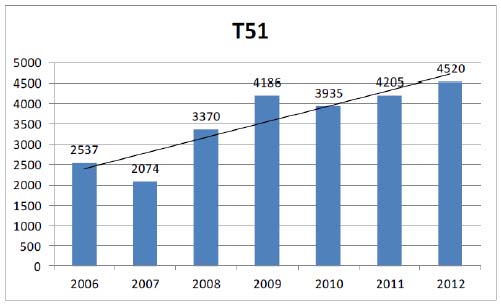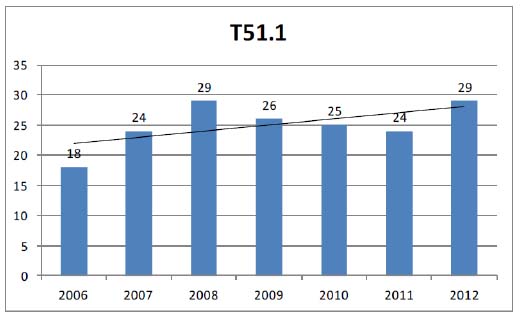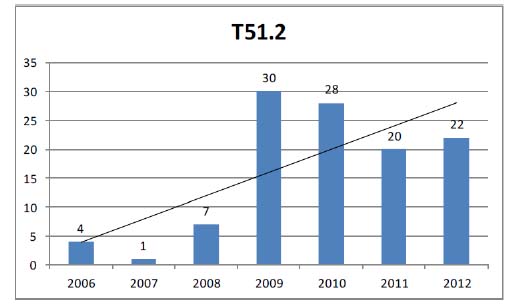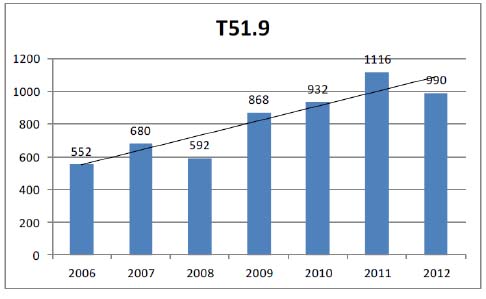Information
Journal Policies
Changes in Hospital Admissions due to Toxic Effects of Alcohols (T51 ICD-10) in the Lower Silesia Region of Poland in the Years 2006-2012 Significant for Emergency Medicine, Medical Intensive Care and Anesthesia
Robert Suslo1, Piotr Hańczyc2, Jaroslaw Drobnik1
2.Lower Silesia Gynecology Center, Wroclaw, 22/1a Krynicka St, 50-555 Wroclaw, Poland.
DOI : dx.doi.org/10.20431/2455-9792.0102003
Copyright : © 2016 Robert S. This is an open access article distributed under the Creative Commons Attribution License, which permits unrestricted use, distribution, and reproduction in any medium, provided the original work is properly cited.
Abstract
Intoxications - both acute and chronic - with different alcohols constitute an important problem of public health and clinical medicine, including intensive care and anesthesiology, in modern societies, also in Poland. A statistical evaluation of the incidence of different kinds of alcohol intoxications in the given population supports the diagnostic decision making process of the clinical medicine physician as well as directs the toxicological examination of autopsy samples in forensic medicine. Data on causes of hospital admissions because of toxic effects of alcohol in the years 2006-2012, made available due to courtesy of the public healthcare insurance provider Narodowy Fundusz Zdrowia in Lower Silesia region of Poland (NFZ), were analyzed in order to find out the current incidence and trends in the most common and important intoxications. There was a regular increase in hospital admissions due to alcohol intoxications in the consecutive years, resulting mainly from the rapid increase in both ethanol and unspecified alcohols intoxications cases. It suggests a negative direction of alcohol consumption habits evolution in the Lower Silesia region of Poland population. There was raising amount of life-threatening intoxications with alcohols contained in industrial-use fluids that are not designed to be consumed by humans or in illegally distilled alcohol beverages. The significant amount of intoxications in which the causing alcohol was not identified suggests that the availability of basic toxicology screening tests may be not adequate in all hospitals in the Lower Silesia region of Poland.
Keywords: Alcohol Intoxication; Public Health; Ethanol; Methanol; Forensic Toxicology.
Abbreviations: NFZ - Narodowy Fundusz Zdrowia in Lower Silesia region of Poland, District Division in Wroclaw.
1.Introduction
Intoxications with different alcohols - both acute and chronic - constitute an important problem of medical professionals and public health in modern societies [1]. Each decade younger and younger people get involved into drinking ethanol beverages and even become addicted to it [2]. The whole health system, family medicine doctors included, has to cope with the demands of diagnosing and treating ethanol abusing patients [3]. Each case of such a patient needs to be properly documented in medical files as there is high chance for it to end up as basis for law enforcement proceeding and in numerous cases even as object of a court trial [4]. There are copious medical conditions that mixed with ethanol abuse may result in serious, sometimes even deadly, complications - such medical conditions encompass both common cases as high blood pressure, atherosclerosis or diabetes as well as under-diagnosed rare genetic based syndromes, which is crucial for anesthesiology and intensive care staff [5]. Ethanol intoxications are the most common ones and they pose a quite serious threat to life as they lead not only to respiratory drive depression - which typically needs high level of ethanol in the blood - but, in the first place, to elevated risk or vomiting and fatal asphyxia due to choking with vomit [6]. It cannot be understated that mild ethanol abuse can mislead a diagnosing emergency medicine physician or a consulting anesthesiologist as it sometimes coexists with several independent life-threatening conditions that imitate the symptoms of deep ethanol intoxication, especially: posttraumatic intracranial hematoma or serious damage of some other inner organ, typically with internal bleeding; acute hyper- or hypoglycemia; deep dehydration; liver insufficiency associated metabolic imbalance; some forms of psychosis or mixed intoxication with medicinal drugs or substances of abuse. Moreover, ethanol is not the only alcohol that can be consumed, sometimes by mistake, and the other alcohols cause much more serious intoxications: the main problem is methanol ingestion, but also consuming 2-propanol, fusel oils and other, unspecified alcohols can lead to serious health damage demanding intensive medical care [7]. Especially the methanol intoxications are often leading to death resulting from accidental exposure [8]. The possibility of mixed intoxication with different alcohols, alcohol and medicinal drugs or even some different toxic substance must be always taken into account in the differential diagnosis [[9]. The accuracy of testing for alcohols’ presence, especially other than ethanol, in hospital laboratories using unspecific tests remains often questionable and in a situation of discrepancy between clinical status of the patient and the test result retesting with specific method shall be obligatory [10]. Even the formally approved procedures applied by the Polish law enforcement agencies in documenting the signs of current degree of intoxication with ethanol in the form of “protocol of obtaining a blood sample” - that shall be filled in on the basis of patient’s evaluation by the physician at the moment of blood sample collection for the purposes of toxicology analysis - show very little practical usefulness [11]. Because of all above-mentioned open possibilities proper medical evaluation and treatment, including anesthesia, of any alcohol intoxicated patient is difficult and the risk of medical mistake is serious - especially taking into account that the symptoms of poisoning with the same toxic substance can vary significantly among different patients [12]. A statistical evaluation of the incidence of different kinds of alcohol intoxications in the given population supports the diagnostic decision making process of the clinical medicine physician as well as directs the toxicological examination of autopsy samples in forensic medicine. It must be remembered though that medical reporting and statistics might be of limited adequacy as it is influenced by many factors, including the adjustments in reported causes of hospitalization to the way the paying institution has shaped the system of payments for health services [13].
2. Materials and Methods
Data on causes of hospital admissions because of toxic effects of alcohol in the years 2006-2012, made available due to courtesy of the public healthcare insurance provider Narodowy Fundusz Zdrowia in Lower Silesia region of Poland (NFZ), were analyzed. The aim of the study was to find out the current incidence and trends in the most common and important intoxications in the analyzed period of time to facilitate the process of toxicology diagnostics for both clinical and forensic medicine purposes.
3. Results and Discussion
Over the years 2006-2012 the population of the Lower Silesia region of Poland, did not change significantly in amount or age structure, although some effects of population ageing were observed [14]. In the year 2014 in the Lower Silesia region there were living 2,9 million people, 48% of them males [15].
The study allowed to gather the information on hospital admissions in the Lower Silesia region of Poland reported as being due to “intoxication with alcohol” (T51 according to ICD-10), without further specification as to characteristics of the substance, as it is shown in Figure 1. During the 7 years long time the amount of those admissions increased by 78,2% of its initial value.
The intoxications with ethanol (T51.0 according to ICD-10) were the major specific cause of hospital admissions in the analyzed group and a significant increase of their amount was observed - by 77,9% of its initial value.
Methanol intoxication related hospital admissions (T51.1 according to ICD-10) were far less numerous than in case of ethanol, but their amount increased in the analyzed period by 61,1% of its initial value.
Hospital admissions caused by isopropyl alcohol intoxications (T51.2 according to ICD-10) were very rare in the beginning of the analyzed period, but their incidence increased rapidly - over four times - in the year 2009 and later dropped only slightly.
Toxic effects of fuse oil, including amyl, butyl and propyl alcohol (T51.3 according to ICD-10) among the causes of admissions to hospital were incidental in the analyzed period, showing slight raising trend.
The amount of hospital admissions caused by intoxications with alcohols other than ethanol, methanol, isopropyl alcohol and fuse oil (T51.8 according to ICD-10) was changing irregularly in the analyzed years.
The amount of patients admitted to Lower Silesia region of Poland because of toxic effects of unspecified alcohols (T51.9 according to ICD-10) doubled in the years 2006-2012.
4. Conclusion
The amount of hospital admissions in the Lower Silesia region of Poland in the years 2006-2012 because of toxic effects of alcohols increased significantly - and it was the effect of regular increase in the consecutive years that suggests a negative direction of alcohol consumption habits evolution.
The high dynamics of raise in hospital admissions because of alcohol intoxications in total was resulting mainly from the rapid increase in both ethanol and unspecified alcohols intoxications cases. The significant amount of intoxications in which the causing alcohol was not identified suggests that the availability of basic toxicology screening tests may be not adequate in all Lower Silesia region of Poland hospitals.
Important problem for medical care, especially intensive care units, and public health of the Lower Silesia region of Poland is associated with raising amount of life-threatening intoxications with alcohols contained in industrial-use fluids that are not designed to be consumed by humans - especially methanol and isopropyl alcohol - or in illegally distilled alcohol beverages, including fusel oil.
Being aware of the up to date statistics of various alcohol intoxications incidence allows both clinically active physicians - including emergency departments, intensive care stations staff, anesthesiologists - and forensic medicine specialists to choose the first aid methods when applicable and to adjust the scope of primary tests applied, limiting the average costs of establishing the diagnosis as well as shortening the time needed for that.
5.Acknowledgments
The authors thank the NFZ for allowing them the access to the publication-relevant data.
References
- Drobnik J, Pastuszka O, Jadach R, Siwek-Jadach K, Suslo R, Pirogowicz I, Trnka J.: Negative health results of alcohol abuse; Bad.Nauk. 2007 Vol.21 nr 2; P 162
- Suslo R, Drobnik J.: Profilaktyka i wykrywanie uzależnień wśród dzieci i młodzieży In: Dziecko i jego środowisko: promocja zdrowia i profilaktyka chorób w pediatrii; Red. Iwona Pirogowicz, Andrzej Steciwko; Wrocław : Wydaw. Continuo, 2007; PP 135-147
- Trnka J, Suslo R, Drobnik J.: Lekarz rodzinny wobec zjawiska nadużywania alkoholu przez pacjentów; Przew.Lek. 2010 nr 2; PP 184-187
- Suslo R, Drobnik J, Trnka J.: Rozpoznawanie i dokumentowanie przypadków przewlekłej intoksykacji wśród pacjentów podstawowej opieki zdrowotnej; Przew.Lek. 2010 nr 2; PP 180-183
- Suslo R, Trnka J, Siewiera J, Drobnik J.: Ondine's curse - genetic and iatrogenic central hypoventilation as diagnostic options in forensic medicine; Adv.Exp.Med.Biol. 2015 Vol.861: Neuroscience and respiration. Vol.14: Respiratory health; PP 65-73
- Trnka J, Gesicki M, Suslo R, Siuta J, Drobnik J, Pirogowicz I.: Death as a result of violent asphyxia in autopsy reports; Adv.Exp.Med.Biol. 2013 Vol.788: Neurobiology of respiration; PP 413-416
- Suslo R, Trnka J, Filinowicz M, Drobnik J.: Zatrucia alkoholami i glikolami In: Medycyna rodzinna - co nowego? Vol.2 ; Red. Andrzej Steciwko; Wrocław: Cornetis, 2010; PP 240-243
- Türkmen N, Eren B, Cetin G.: Fatal methanol ingestion in a child: case report; Acta Medica (Hradec Kralove). 2009;52(3): PP 125-7
- Gürses M, Türkmen N, Eren B, Çetin S, Gündoğmuş U.: Death due to combined intake of Eethanol and toluene: a case report; Maedica (Buchar). 2014 Dec; 9(4): PP 398–400
- Cywka T, Teresinski G, Ćwiklinska M, Buszewicz G., Matysiak P.: Discrepancies between diagnoses of methanol and ethylene glycol intoxication based on determinations performed in the regional clinical toxicology centre and in the department of forensic medicine; Arch.Med.Sad.Krym. 2014; 64 (1): PP 8–19
- Engelgardt P, Grzech W, Drzewiecki J, Sliwka K.: Evaluating the applicability of medical examinations constituting „the protocol of obtaining a blood sample” in measuring the degree of intoxication; Arch.Med.Sad.Krym., 2010, LX: PP 223-234
- Wachowiak R.: Evaluation of detoxification procedures - treatment of poisonings in opinionating casuistry of the Department of Forensic Medicine in Poznan - failures and mistakes; Arch.Med.Sad.Krym., 2007, LVII: PP 236-244
- Drobnik J.: Ocena wybranych parametrów świadczeń zdrowotnych i systemu sprawozdawczości w ochronie zdrowia w zakresie analizy trendów epidemiologicznych i potrzeb zdrowotnych oraz ich wpływ na wybrane elementy polityki zdrowotnej na podstawie danych z województwa dolnośląskiego, Wroclaw; Akad. Med., 2011; PP 241-243
- Drobnik J, Suslo R, Kurpas D, Trnka J.: Analysis of elderly people care system and their health needs in the Lower Silesia region; Fam.Med.Prim.Care Rev. 2010 Vol.12 no.2; PP 165-167
- Central Statistical Office of Poland Information Portal
http://stat.gov.pl/statystyka-regionalna/rankingi-statystyczne/ludnosc-wedlug-wojewodztw/ (accessed: 22.05.2016)












